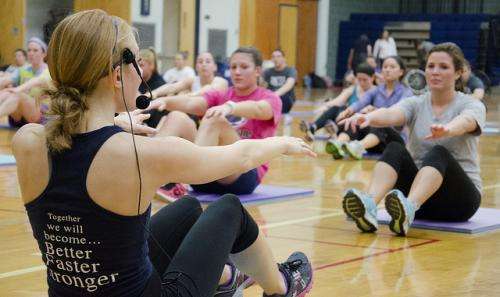The participants improved in both confidence and ability to move their stroke-affected arm and hand over both two-week training sessions, but they displayed a greater magnitude of improvement after the action observation phase. Credit: Penn State
Stroke survivors with impaired mobility in their arms appear to significantly improve in both motor function and confidence when they observe an individual performing a task and then mimic their actions.
Observing another individual performing a task is known as action observation, and appears to prime the motor system by engaging the same regions in the brain of the observer that would be engaged when physically performing the task.
Previous studies using action observation for stroke recovery have produced inconsistent results, however Murdoch University PhD student Kita Sugg says the timing between the action observation and task performance is too long in these studies.
"We reasoned if there was very little delay between the action observation and task performance, a greater benefit would be achieved," she says.
"Our study reduced the duration of action observation of a single task to 30 seconds [as opposed to two-six minutes in previous studies], and followed this observation period immediately with physical practice of the same task."
The researchers recruited 14 chronic stroke survivors from Australian National Stroke Foundation support groups across Perth.
Small-scale study tests impairment level
Each participant underwent motor and cognitive assessments—Upper Extremity Fugl-Meyer Motor Assessment, Functional Test of the Hemiparetic Upper Extremity and Montreal Cognitive Assessment—to ensure they could at least partially move their upper limbs and could communicate effectively.
"They displayed a range of motor impairments," Ms Sugg says.
"Those with nearly normal movements except manual dexterity in their fingers; those who could only move their shoulder and elbow through partial range of motion with no movement of the hand or fingers; and those [with only] the slightest movement in the shoulder."
Participants completed two weeks of 'relaxation-sham plus physical practice'; the control condition where they watched nature footage prior to physical practice.
Thereafter, they participated in two weeks of action observation training with immediate physical practice.
The participants improved in both confidence and ability to move their stroke-affected arm and hand over both two-week training sessions, but they displayed a greater magnitude of improvement after the action observation phase.
"Some participants were ecstatic about their improvements…doing up their own buttons, cutting meat at meals and some reclaimed their drivers licences," Ms Sugg says.
Ms Sugg says their research on action observation shows promise to improve motor function in chronic stroke survivors but she says the results could be explained by other factors and not just the action observation-practice intervention.
She recommends more rigorous clinical trials with follow-up assessments.
More information: "Does Action Observation Training With Immediate Physical Practice Improve Hemiparetic Upper-Limb Function in Chronic Stroke?" Neurorehabil Neural Repair. 2015 Jan 22. pii: 1545968314565512 www.ncbi.nlm.nih.gov/pubmed/25613984
Provided by Science Network WA






















